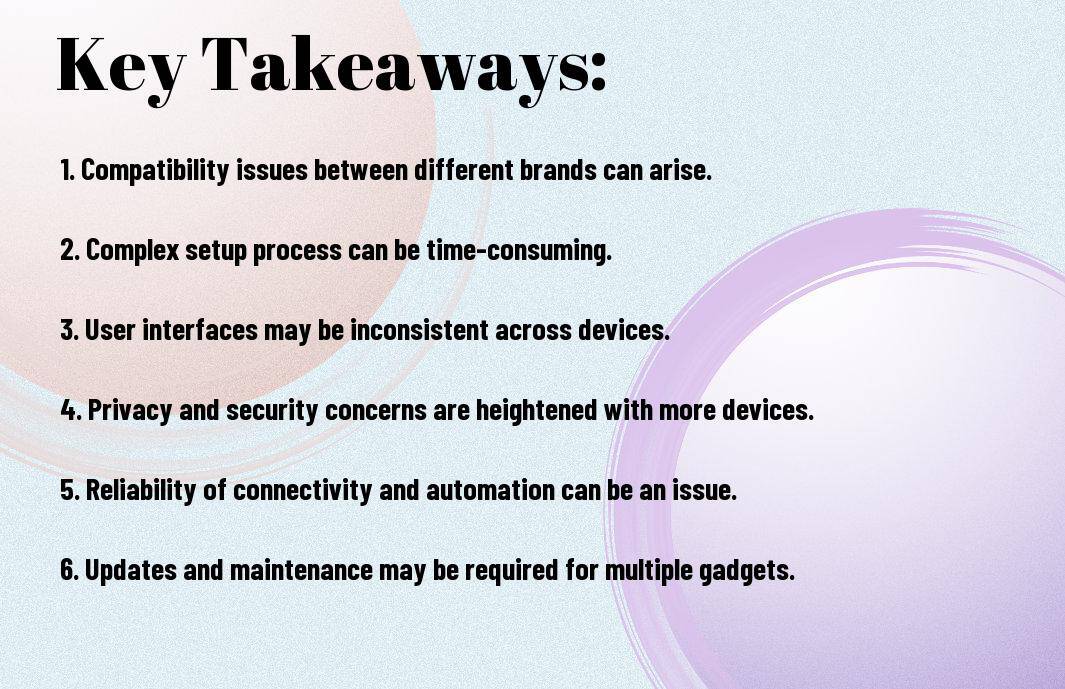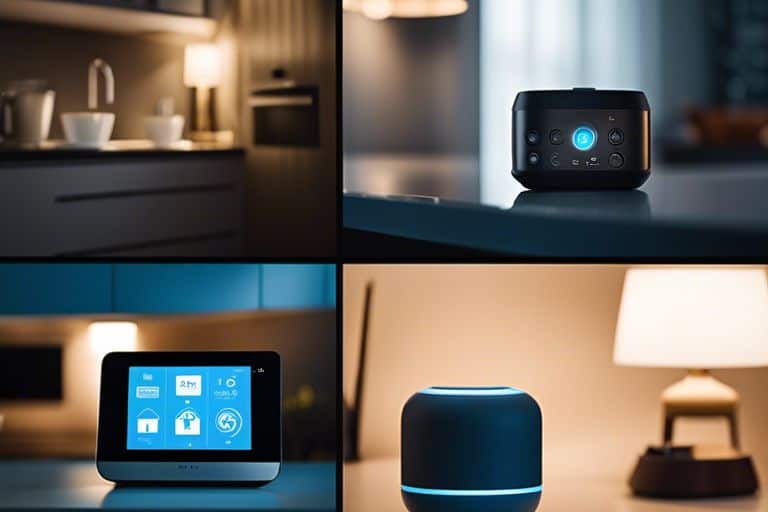Integrating multiple smart home gadgets into a cohesive system can be a daunting task for many homeowners. With the growing popularity of smart home technology, many are finding themselves overwhelmed by the complexity and compatibility issues that come with juggling different devices. From incompatible protocols to security concerns, there are numerous challenges that you might face when attempting to create a seamless smart home environment. In this blog post, we will discuss the most common obstacles and provide you with valuable insights to help you successfully integrate your smart home gadgets into a cohesive system.
Key Takeaways:
- Interoperability: One of the main challenges of integrating multiple smart home gadgets is ensuring that they can all communicate and work together seamlessly.
- Complexity: Managing multiple smart home gadgets can be complex and overwhelming, especially when dealing with different apps, interfaces and protocols.
- Cost: Integrating multiple smart home gadgets into a cohesive system can be costly, as each gadget may require its own hub or controller.
- Security: Connecting multiple smart home gadgets can pose security risks, as each device can potentially serve as a point of entry for hackers.
- User Experience: Ensuring a seamless and intuitive user experience across different smart home gadgets can be challenging, as each device may have its own unique features and limitations.
Compatibility Challenges
When integrating multiple smart home gadgets into a cohesive system, you are likely to encounter several compatibility challenges. These challenges can arise from differences in communication protocols and standards, as well as operating system and manufacturer limitations.
Communication Protocols and Standards
One of the major challenges you may face when integrating smart home gadgets is the varying communication protocols and standards used by different devices. For instance, one smart light may use Wi-Fi, while another uses Zigbee or Z-Wave. This can make it difficult for these devices to communicate with each other, leading to a disjointed and inefficient smart home system. It is important to research and ensure that the devices you plan to integrate are compatible with each other and use the same communication protocols.
Operating System and Manufacturer Limitations
Another challenge in integrating multiple smart home gadgets is the limitations imposed by different operating systems and manufacturers. Some devices may only be compatible with specific operating systems, such as iOS or Android, which can restrict the interoperability of your devices. Additionally, certain manufacturers may have proprietary systems that are not compatible with other brands, creating further barriers to integration. To avoid this, you should carefully consider the compatibility of devices and ensure they are not limited by specific operating systems or manufacturers.
“`html
User Experience Issues
When integrating multiple smart home gadgets into a cohesive system, you may encounter various user experience issues that can affect the overall functionality and convenience of your smart home setup.
Complexity of Setup and Maintenance
One of the major user experience challenges you may face is the complexity of setting up and maintaining multiple smart home devices. Each gadget may come with its own set of installation instructions, compatibility requirements, and software updates. This can be overwhelming and time-consuming, especially if you are not tech-savvy. Additionally, troubleshooting and resolving issues with multiple devices can be a daunting task, requiring a significant amount of effort and patience.
Interoperability and Usability Concerns
Another key user experience issue is the interoperability and usability concerns that arise when integrating various smart home gadgets. Not all devices are designed to seamlessly work together, leading to compatibility issues and a disjointed user experience. For example, you may find that certain smart home devices do not communicate effectively with each other, leading to inefficiencies and frustration. Furthermore, the user interface and controls for each device may vary, making it challenging to create a cohesive and intuitive user experience across your entire smart home ecosystem.
“`
Security and Privacy Considerations
When integrating multiple smart home devices into a cohesive system, it is crucial to consider the security and privacy implications. As you connect more devices to your home network, you are potentially increasing the points of vulnerability that could be exploited by cybercriminals. It is essential to take precautions to safeguard your data and protect your privacy.
Data Protection and Encryption
One of the primary concerns when integrating multiple smart home gadgets is ensuring the protection of your data. Your personal information and usage patterns are valuable to cybercriminals, so it is crucial to implement robust data protection measures. Ensure that the devices you are integrating support encryption to secure your data as it is transmitted and stored. Look for devices that adhere to industry-standard encryption protocols to minimise the risk of unauthorised access to your data.
Network Vulnerabilities and Malicious Threats
Integrating multiple smart home gadgets also increases the risk of network vulnerabilities and malicious threats. Each device connected to your network represents a potential entry point for cyber attacks. Regularly update the firmware and software of your smart home devices to patch known vulnerabilities. Consider implementing network security measures, such as setting up a separate guest network for your smart home devices and using a firewall to monitor and control incoming and outgoing traffic.
Future Outlook
As you continue to navigate the challenges of integrating multiple smart home gadgets into a cohesive system, it’s essential to consider the future outlook of the industry. One valuable resource for staying updated on the latest innovations and industry insights is the article ‘Why Hiring a Smart Home Technology Integrator is Worth It’. You can find it here.
Innovations on the Horizon
Looking ahead, the smart home technology landscape is filled with exciting developments. From advanced AI capabilities that enhance predictive maintenance and energy efficiency to seamless integration with wearable devices, there are numerous innovations on the horizon. This means that your smart home will become even more efficient and convenient, offering you greater control and peace of mind. Stay informed about these innovations to make sure your integrated system is always at the cutting edge of technology.
Integration Strategies and Industry Initiatives
In the coming years, expect to see increased collaboration among smart home device manufacturers and service providers. This will lead to more streamlined integration strategies and industry initiatives aimed at enhancing interoperability between different gadgets and systems. By staying abreast of these developments, you can ensure that your integrated smart home functions smoothly and securely, with improved compatibility and reduced cybersecurity risks. The industry is moving towards standardisation and best practices, so it’s important to keep an eye on how these developments can benefit your own smart home integration.

Challenges of Integrating Multiple Smart Home Gadgets
From above, you can see that integrating multiple smart home gadgets into a cohesive system presents several challenges. One of the main challenges is ensuring compatibility between different devices and platforms. Additionally, managing and coordinating the various functionalities of the different gadgets can be complex and time-consuming. Moreover, security and privacy concerns also arise when integrating multiple smart home gadgets, as each device may have different security protocols and vulnerabilities. Therefore, it is important to carefully research and plan the integration of your smart home gadgets to ensure a seamless and secure system.
FAQ
Q: What are the challenges of integrating multiple smart home gadgets into a cohesive system?
A: Integrating multiple smart home gadgets into a cohesive system can be challenging due to compatibility issues, connectivity issues, and the complexities of managing different devices and their corresponding apps.
Q: How do compatibility issues affect the integration of smart home gadgets?
A: Compatibility issues arise when certain smart home gadgets are not designed to work together, leading to difficulties in creating a cohesive system. This can result in limited functionality and frustration for the user.
Q: What are the common connectivity issues faced when integrating smart home gadgets?
A: Common connectivity issues include unreliable Wi-Fi connections, signal interference, and the need for separate hubs or bridges to connect different devices. These issues can hinder seamless integration and control of smart home gadgets.
Q: How do the complexities of managing different devices and their apps impact integration?
A: Managing multiple devices and their corresponding apps can be overwhelming and time-consuming. Users may struggle with setting up, customizing, and troubleshooting each gadget, leading to a fragmented and disjointed smart home system.
Q: What role does data security play in the integration of smart home gadgets?
A: Integrating multiple smart home gadgets raises concerns about data security and privacy. Ensuring that each device is secure and protected from cyber threats is crucial to maintaining the integrity of the cohesive smart home system.
Q: How can interoperability standards help address the challenges of integrating smart home gadgets?
A: Interoperability standards, such as industry-wide protocols and certifications, can promote seamless integration by ensuring that different smart home gadgets can communicate and work together effectively. This can mitigate compatibility issues and enhance user experience.
Q: What steps can users take to overcome the challenges of integrating multiple smart home gadgets?
A: Users can overcome integration challenges by researching compatibility before purchasing new gadgets, investing in a robust Wi-Fi network, consolidating devices with a smart home hub, and regularly updating firmware and security measures. Seeking professional assistance may also be beneficial.
